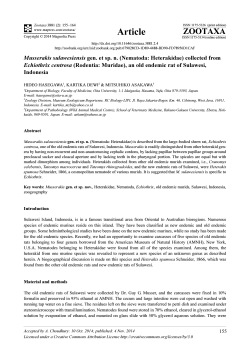
The Impact of Ecological Factors on the Prevalence
The Impact of Ecological Factors on the Prevalence of Tick-borne Pathogens in Endemic and Non-endemic Regions in Estonia K.Värv 1, 2, J. Remm 3,O. Katargina 1, 4, J. Geller 1, Å. Lundkvist 4, I. Golovljova 1 1 - National Institute for Health Development, Tallinn Estonia; 2 - Tallinn University of Technology, Tallinn, Estonia; 3 - University of Tartu, Tartu, Estonia, 4 - Uppsala University, Uppsala, Sweden Introduction Ticks, obligatory hematophagous ectoparasites, are able to carry and transmit a wide range of infectious microorganisms, including viruses, bacteria and protozoa. In recent decades, the incidence of tick-associated diseases has increased considerably across the Northern Hemisphere, making tickborne infections a great public health concern. Ecological changes are considered to be one of the main drivers in the emergence of these infectious diseases, as tick-borne pathogens (TBP) are greatly dependent on the environmental conditions. There are several ecological factors that may influence the prevalence of TBP in their natural foci, for example, climate, vegetation, vector-host community composition and density. The purpose of the study was to estimate the impact of ecological factors on the prevalence of tick-borne pathogens in Estonia. Three endemic and two non-endemic regions were chosen based on the national TBP infection statistics. Materials and methods Results Selected sites were used for the trapping of small mammals with standard Sherman LFA perforated live-traps. Each captured animal was carefully examined for the presence of ectoparasites. In addition, questing ticks were collected from the vegetation using the standardized flagging technique. The track and sign counts of medium-sized and large mammals were recorded around tapping locations. The structure of local flora was described. Obtained tick specimens were identified to species level and the DNA/RNA of each individual was extracted with TriPure isolation kit (Roche Diagnostics, UK). The presence of Borrelia burgdorferi s.l. or Tick-borne Encephalitis virus was determined using previously described protocols (Postic et al. 1994, Rar et al. 2005, Schwaiger and Cassinotti 2003). All positive PCR results were confirmed by DNA sequencing. 823 rodents from 6 species were captured during the study from 2012 to 2014 with Myodes glareolus and Apodemus flavicollis being the most dominant species encountered. We did not find a significant difference in the abundance of small mammals among chosen sites (fig. 1). The abundance indexes for larger mammals were also comparable between endemic and non-endemic areas with the only exception being Sus scrofa. More track counts were witnessed in low risk areas for the wild boar (p<0.05). A total of 4643 tick were collected, either from the vegetation or removed from rodents. The average tick abundance in questing and on-host subsets was statistically higher in endemic regions (p<0.05). The dissimilarity resulted in enhanced co-feeding incidences in high risk areas during spring time, when the rodent abundance was generally low (fig. 2). The presence of Tick-borne Encephalitis virus (TBEV) and Borrelia burgdorferi s.l. was determined in collected ticks and captured rodents. Interestingly, TBEV was only found in endemic locations. Borrelia burgdorferi s.l. demonstrated a wider distribution, and was found in comparable levels in both low-risk and highrisk areas (fig. 3). Endemic Non-endemic ± 95% CI 60 Endemic Catch / trap night 50 Prevalence (%) Non-endemic 40 30 20 10 0 Rodents Month Fig.1. Rodent abundance in endemic and non-endemic areas Number of ticks per host Endemic Non-endemic ± 95% CI Ticks Fig. 3. Mean Borrelia burgdorferi s.l prevalence in endemic and non-endemic locations with standard deviation Conclusions Estonia, located in the northeastern part of Europe, is currently a high risk area for tick-associated diseases. In the country, endemic and non-endemic regions for TBPs are quite well defined, but the reason behind the division is still unclear. The results of current study indicate that the main difference lays in the abundance of ticks within these areas. With high tick numbers the possibility of co-feeding is increased, therefore allowing pathogen transmission. The importance of this transmission mode for TBEV is widely accepted, and may explain the lack of circulating virus in non-endemic locations. Catch / trap night Fig. 2. Number of ticks feeding on small mammals
© Copyright 2025










